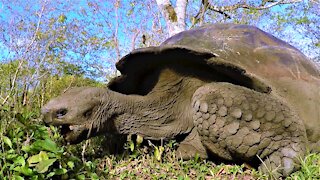Premium Only Content

Giant lobster is very curious about diver's camera
Caribbean lobsters, also known as spiny lobsters, are a large and interesting creature found in the reefs of tropical waters, and also in Ireland, New Zealand, South Africa, and Australia. They have exoskeletons and resemble the lobster that we typically think of; the Atlantic lobster, but they do not have the large claws.
This lobster was out for a walk along the reef, exploring, or seeking a new territory. They typically spend their days hiding under crevices and rocks, coming out at night to feed. But pressure from other lobsters for habitat, or the desire to breed, will bring them out on the daytime on occasion.
A full grown lobster has an extremely thick and hard shell, and is no easy prey for most reef animals, so wandering in the daylight is not a particularly risky venture for a lobster of this size.
This handsome fellow attracted the attention of a scuba diver who was out capturing photographs of the animal life in the Cayman Islands. As the photographer approached, the lobster became very curious, extending his antennae to meet the camera. He even walked toward the camera, as if to pose for a few photos. Spiny lobsters use their antennae to smell and taste substances in the water to help them explore their surroundings and find food. They also use the earth's magnetic field to navigate.
Having relatively poor eyesight, spiny lobsters will use their antennae to explore and check out their surroundings, as well as approaching creatures. The spines are solid, and lined with sharp spikes, an effective deterrent to many predators. Their antennae are at least as long as the rest of their bodies and often give away their hiding spots by sticking out visibly. These lobsters can often be seen in pairs or groups as large as 20.
Prized for food, they are harvested in most countries. They are also a welcome sight for scuba divers and underwater photographers.
-
 1:57
1:57
WildCreatures
20 days ago $7.12 earnedCurious wild deer comes to share a snack with man in forest
46.4K15 -
 0:45
0:45
KristysWorld
5 years ago $1.21 earnedCurious sea turtle nibbles and investigates scuba diver's camera
2.22K2 -
 0:32
0:32
WildCreatures
5 years ago $1.96 earnedGiant Galapagos Tortoise runs over camera left on the trail
6.96K1 -
 0:55
0:55
Jono
4 years ago $0.77 earnedCurious lion gets a bit too close to campsite
1.59K2 -
 1:14
1:14
GalapagosGuys
4 years ago $14.93 earnedExtremely curious whale shark surfaces to investigate people on boat
6.92K9 -
 1:24
1:24
WildCreatures
4 years ago $0.49 earnedAncient giant tortoise happily munches away on his breakfast
3.44K -
 1:04
1:04
mickeysutube
4 years agoBackyard camera captures baby fox's encounter with a hedgehog
108K34 -
 1:04
1:04
WildCreatures
4 years ago $1.90 earnedGiant watersnake claims family dock as his sunbathing spot
13.6K37 -
 10:52:37
10:52:37
GritsGG
18 hours agoWin Streaking! Most Wins 3180+! 🔥
106K2 -
 3:01:03
3:01:03
This is the Ray Gaming
10 hours agoSunday Night LIVE | Rumble Premium Streamer
35.5K